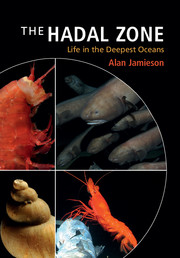Book contents
- Frontmatter
- Dedication
- Contents
- Preface
- Acknowledgements
- Part I History, geology and technology
- 1 The history of hadal science and exploration
- 2 Geography and geology
- 3 Full ocean depth technology
- Part II Environmental conditions and physiological adaptations
- Part III The hadal community
- Part IV Patterns and current perspectives
- Appendix
- References
- Index
- Plate section
1 - The history of hadal science and exploration
from Part I - History, geology and technology
Published online by Cambridge University Press: 05 February 2015
- Frontmatter
- Dedication
- Contents
- Preface
- Acknowledgements
- Part I History, geology and technology
- 1 The history of hadal science and exploration
- 2 Geography and geology
- 3 Full ocean depth technology
- Part II Environmental conditions and physiological adaptations
- Part III The hadal community
- Part IV Patterns and current perspectives
- Appendix
- References
- Index
- Plate section
Summary
The history of hadal science and exploration is a peculiar story and, largely due the challenges of sampling at such extreme depths, research effort seems to have occurred in waves. Major events in this history are often as disjunct as the trenches themselves. Around the turn of the twentieth century, early pioneers began sampling at greater and greater depths. Following the burst of curiosity concerning the extent to which animal life could be found and the true depths of the oceans, there was a lull in progress. It was in the 1950s when the first major hadal sampling campaigns began with the extensive series of Soviet RV Vitjaz expeditions and the round the world Danish RV Galathea expeditions. The Vitjaz continued to periodically sample the great depths for some time but, in general, research campaigns were few and infrequent. The first manned dive to the deepest place on Earth took place in 1960 amidst a myriad of public interest. However, it was the first and only time that this submersible ventured to the bottom of a trench.
The 1990s saw new interest in the trenches when the Japan Agency for Marine-Earth Science and Technology (JAMSTEC) developed the first full ocean depth remotely operated vehicle (ROV) named Kaikō. Kaikō was used numerous times in the trenches and provided scientists with the tools to access full ocean depth. Aside from JAMSTEC, few other academic institutes were involved in hadal research until the mid-2000s.
- Type
- Chapter
- Information
- The Hadal ZoneLife in the Deepest Oceans, pp. 3 - 21Publisher: Cambridge University PressPrint publication year: 2015



